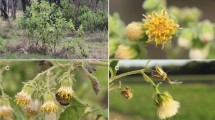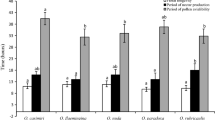Abstract
The pollination biology, breeding system and fruiting success ofCaesalpinia calycina andC. pluviosa var.sanfranciscana were studied in caatinga vegetation in Bahia, NE Brazil. The principal pollinators for both species were carpenter bees.Caesalpinia calycina is andromonoecious but inC. pluviosa all flowers are hermaphrodite. InC. calycina all selfed flowers were abscised within 72 h despite rapid self-pollen tube growth to the ovary and ovule penetration. Prevention of selfing therefore seems to be controlled by a post-zygotic mechanism. Both species had very low fruit-set and it is suggested that this is at least in part due to geitonogamous pollinations with ovule penetration by self pollen tubes.
Similar content being viewed by others
References
Arroyo, M. T. K., 1981: Breeding systems and pollination biology inLeguminosae. — InPolhill, R. M., Raven, P. H., (Eds): Advances in legume systematics,2, pp. 723–769. — Richmond: Royal Botanic Gardens, Kew.
Bawa, K. S., 1974: Breeding systems of tree species of a lowland tropical community. — Evolution28: 85–92.
—, 1989: Seed: ovule ratios, selective seed abortion, and mating systems inLeguminosae. — InStirton, C. H., Zarucchi, J. L., (Eds): Advances in legume biology. Monogr. Syst. Bot. Missouri Bot. Gard.29: 243–262.
—, 1984: Flower, fruit and seed abortion in tropical forest trees: implications for the evolution of paternal and maternal reproductive patterns. — Amer. J. Bot.71: 736–751.
Bertin, R. I., 1993: Incidence of monoecy and dichogamy in relation to self-fertilization in angiosperms. — Amer. J. Bot.80: 557–560.
Bierzychudek, P., 1981: Pollinator limitation of plant reproductive effort. — Amer. Naturalist.117: 838–840.
Bubar, J. S., 1959: Differences between self-incompatibility and self-sterility. — Nature183: 411–412.
Bullock, S. H., 1985: Breeding systems in the flora of a tropical deciduous forest in Mexico. — Biotropica17: 287–301.
Cocucci, A. A., Galetto, L., Sersic, A., 1992: El sindrome floral deCaesalpinia gilliesii (Fabaceae-Caesalpinioideae). — Darwiniana31: 111–135.
Cruden, R. W., 1976: Intraspecific variation in pollen-ovule ratios and nectar secretion — preliminary evidence of ecotypic adaptation. — Ann. Missouri Bot. Gard.63: 277–289.
—, 1979: Butterfly pollination ofCaesalpinia pulcherrima, with observations on the psychophilous syndrome. — J. Ecol.67: 155–168.
Gibbs, P. E., Sassaki, R., 1998: Reproductive biology ofDalbergia miscolobium Benth. (Leguminosae-Papilionoideae) in SE Brazil: the effects of pistillate sorting on fruit-set. — Ann. Bot.81: 735–740.
Johansen, J., 1940: Plant microtechnique. — New York: McGraw-Hill.
Jones, C. E., Buchman, S., 1974: Ultraviolet floral patterns as functional orientation cues in hymenopterous pollination systems. — Anim. Behav.22: 481–485.
Kenrick, J., Kaul, V., Williams, E. G., 1986: Self-incompatibility inAcacia retinodes: site of pollen-tube arrest is the nucellus. — Planta169: 245–250.
Klekowski, E. J., 1988: Mutation, developmental selection and plant evolution. — New York: Columbia University Press.
Lewis, G. P., 1998:Caesalpinia: a revision of thePoincianella-Erythrostemon group. pp. 233. — Richmond: Royal Botanic Gardens, Kew.
Martin, F. M., 1959: Staining and observing pollen in the style by means of fluorescence. — Stain Technol.34: 125–128.
Owens, S. J., 1989: Stigma, style, pollen, and the pollen-stigma interaction inCaesalpinioideae. — InStirton, C. H., Zarucchi, J. L., (Eds): Advances in legume biology. — Monogr. Syst. Bot. Missouri Bot. Gard.29: 113–126.
Ramirez, N., Sobrevila, C., de Enrech, N. X., Ruiz-Zapata, T., 1984: Floral biology and breeding system ofBauhinia benthamiana Taub. (Leguminosae), a bat-pollinated tree in the Venezuelan “Llanos”. — Amer. J. Bot.71: 273–280.
Sage, T. L., Bertin, R. I., Williams, E. G., 1994: Ovarian and other late-acting self-incompatibility systems. — InWilliams, E. G., Knox, R. B., Clarke, A. E., (Eds): Genetic control of self-incompatibility and reproductive development in flowering plants, pp. 116–140. — Amsterdam: Kluwer.
Seavey, S. R., Bawa, K. S., 1986: Late-acting self-incompatibility in angiosperms. — Bot. Rev.52: 195–217.
Vogel, S., 1990: Radiación adaptiva del síndrome floral en las familias neotropicales. — Bol. Acad. Nac. Ci.59: 5–30.
Waser, N. M., Price, M. V., 1991: Reproductive costs of self-pollination inIpomopsis aggregata (Polemoniaceae): are ovules usurped? — Amer. J. Bot.78: 1036–1043.
Webb, C. J., Bawa, K. S., 1985: Patterns of fruit and seed production inBauhinia ungulata (Leguminosae). — Pl. Syst. Evol.151: 55–65.
Willson, M. F., Schemske, D. W., 1980: Pollinator limitation, fruit production and floral display in pawpaw (Asimina triloba). — Bull. Torrey Bot. Club107: 401–408.
Author information
Authors and Affiliations
Rights and permissions
About this article
Cite this article
Lewis, G., Gibbs, P. Reproductive biology ofCaesalpinia calycina andC. pluviosa (Leguminosae) of the caatinga of north-eastern Brazil. Pl Syst Evol 217, 43–53 (1999). https://doi.org/10.1007/BF00984921
Received:
Revised:
Accepted:
Issue Date:
DOI: https://doi.org/10.1007/BF00984921




